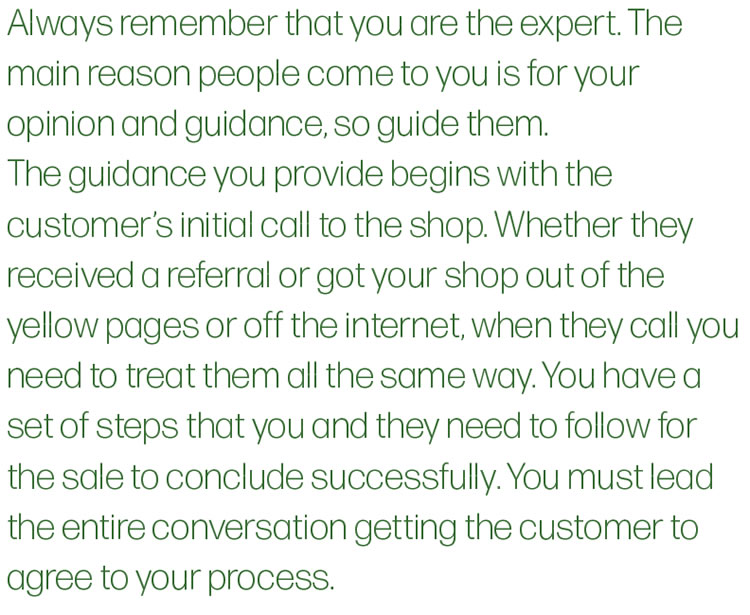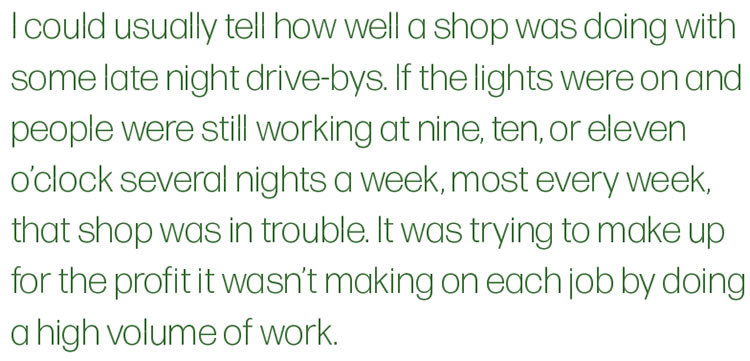It’s Your Business
Selling can be hard work that pays off well or easy work that doesn’t. While it may not be a major rule of selling it is a very important one. It has to do with how hard you want to work physically as opposed to mentally. Again, like as in most other areas, you have a choice. You can either work hard at learning how to deal with customers to get what you need for the success of your business or if you don’t want to do that you can work on lots of cars, well into the night at times, to make up for the fact that you aren’t selling jobs the way they need to be sold to do what’s right for both you and your customers.

I could usually tell how well a shop was doing with some late night drive-bys. If the lights were on and people were still working at nine, ten, or eleven o’clock several nights a week, most every week, that shop was in trouble. It was trying to make up for the profit it wasn’t making on each job by doing a high volume of work. While the thinking behind that decision is understandable it can also be dangerous in a number of ways.
Let’s start with the fact that even the busiest of shops isn’t busy all the time, so if the shop is only surviving by pushing a lot of low or no profit jobs through the bays and the shop gets quiet for a few weeks or more it could start falling behind on its payments to the landlord, the bank, the suppliers, the sales tax collector, or the IRS. Then if business picks up and the shop isn’t charging enough to make up for its shortfall it could easily go under in a short time even though it seems busy.
Another consideration is the employees. How long can they go on working long hours several nights a week without it affecting their safety and the quality of the work they are producing? Any owner who has worked on cars knows how hard the job is on the body as well as the mind. Without proper rest early burnout is a distinct possibility. Certain mistakes can be deadly and the more tired a person is the more likely it is to make them.

Most employees don’t want to work in a shop that isn’t making money. There is a constant threat that the shop will go under leaving them without a job. They can also see when customers aren’t being well treated or charged enough for the shop to be profitable. Although most won’t say anything, some more outspoken employees might ask the owner why the shop isn’t charging enough to stay afloat.
Often owners won’t charge enough for their work because they are convinced that asking for the right price will scare off their customers. What they don’t understand is that it won’t scare them all off, just the ones who are unwilling to let the shop make a profit and those are the customers the shop doesn’t need in the first place. That’s right; you don’t need every customer who calls or comes into the shop, just the ones who want their cars fixed right and are willing to pay for it.
What you have to remember is that the shop isn’t there to exchange dollars, it is there to make a profit and the only way that happens is if the owner figures out the cost of doing business and then prices out jobs to include that cost and the profit that’s needed.
Learning how to sell properly, how to say the right words at the right time is something that many mechanical types have not been taught. If anything they were taught what it takes to fix cars so they operate from that point of view, but you can’t really be successful at fixing cars if you don’t know how to get the customers to agree to pay a fair amount of money for the work you do.

Just like there are techniques and steps involved in repairing a car there is a blueprint for making sales as well. If you don’t follow it, if you cut corners, if you are afraid to ask for what you really need, if you think that all the steps are unnecessary so you skip some, or if you are just being lazy, you are not really selling; you are putting a number out there and hoping customers will say yes to it. What do you do though when they don’t accept your number, when they come back at you with objections like “Your price is too high; that’s too much money; I can’t afford it; or I can get it done cheaper?” Do you fold up your tent and immediately drop your price to a number that doesn’t leave you with a decent profit because you don’t know how to handle those objections successfully?
If you learn and follow all the steps in the sales procedure those objections won’t come up nearly as often because the process is designed to have the customer go along with you through every phase so saying yes to the final question isn’t such a big deal or isn’t coming out of left field.
Of course there are times when no matter how well you stick to the game plan customers will come up with objections that you will need to answer in order to close at the price you need, so you do have to study and practice them until they automatically come out of your mouth whenever you are challenged with them.
As the old expression goes, “Number of times through equals certainty.” The more you learn, practice, and use the techniques the surer and more comfortable you get with them and people can see it. The more definite you sound when you say something the more, they tend to believe it and follow along. For example; if you know that a vehicle needs a certain preventive maintenance procedure or repair it is not a good idea to just mention it offhand and hope that the customer will pick up on the clue and tell you to go ahead and do it. You need to direct the customer to do what you know is right so you might say, “You need this repair done now, before it affects anything else, or you need to have this fluid changed before it causes a problem.” Always remember that you are the expert. The main reason people come to you is for your opinion and guidance, so guide them.
The guidance you provide begins with the customer’s initial call to the shop. Whether they received a referral or got your shop out of the yellow pages or off the internet, when they call you need to treat them all the same way. You have a set of steps that you and they need to follow for the sale to conclude successfully. You must lead the entire conversation getting the customer to agree to your process.

While we know that most callers will ask for a price within the first few moments of the conversation we also know that if we just blurt out a number to answer their inquiry we will, in about 80% of cases lose them immediately. They will hang up, armed with a number that really doesn’t mean anything, but they don’t know that. They often think they can just use that number to get others and maybe find the cheapest way to go about getting the car fixed. As much as we know that isn’t the right way for customers to shop for auto repairs, they don’t. They are usually asking for a price because they don’t know what else to ask. They are not mechanics, generally, so the only question they can think of that applies to any product of service is, “How much does it cost?” We shouldn’t hold it against them for asking that question, but we also shouldn’t try to answer it.
We are not ready to quote a price, especially on a repair, without going through a diagnostic process that pinpoints the problems and indicates the necessary labor and parts it will take to perform the repair properly. To do that we must have the opportunity to see and drive the vehicle (if it’s drivable) to make a proper assessment before quoting any price.
Your only job on that initial phone call has nothing to do with trying to make a diagnosis or give any idea of price because either of those can likely scare the customer off. It is only to get four wheels firmly planted in your driveway either by the caller driving the vehicle to your shop or allowing you to tow it in.

People tend to respond well when offered hope. In our case it’s usually the hope that however bad they think the problem is, it may not be. Since most people think that whenever anything is wrong with a transmission it’s going to be a major job it’s another reason, they say things like, “What’s the most it can cost me?” We, if anything, need to minimize the problem in their minds so they will want to give us a chance to take a look. I’ve often heard service writers say things to customers on the phone that are the exact opposite of what they should be saying. For example; a customer describes a problem and the service writer says: “That sounds pretty bad. Yeah, you’re going to need that transmission rebuilt.” Of course, that prompts the next question, “How much?” Then if a price is quoted the customer hangs up and is gone. So by the service writer saying how bad the problem sounded all hope of saving any money was taken away and then a number was thrown in from left field to make the customer feel even worse.
One thing we never want to do is agree with a caller that their problem sounds like it’s really bad; first off because we don’t know at that point and second because guessing scares customers away. What we want to do is give them the hope that if we have the opportunity to check it out, we might find a better and/or less expensive way to solve the problem. Convince customers of that and they will beat a path to your door.

Autumn Special
Now you can purchase one copy of Terry Greenhut’s 450 page book “How to Market and Sell Automotive and Transmission Service and Repair” for only $49.16. In addition you can now own the complete set of Terry’s 9 hour sales course “How to Sell Automotive Service and Repair for only $486.43 for the video DVDs or $278.37 for the audio CDs. To take advantage of any of these great opportunities visit www.terrygreenhut.com or call Terry directly at 914-882-3003 to place your credit card order. Don’t wait. Let’s make this your best year ever.














